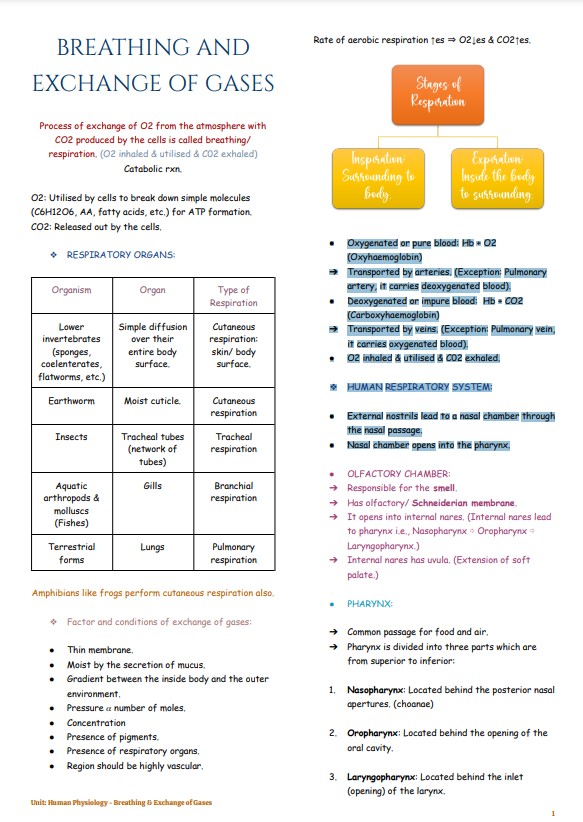Breathing and Exchange of Gases
Summary:
Breathing is the process of exchanging oxygen and carbon dioxide, which occurs through different respiratory organs in various organisms. The human respiratory system consists of different parts, including the nasal chamber, pharynx, larynx, trachea, bronchi, bronchioles, and alveoli. The primary site of gaseous exchange is the alveoli, where oxygen and carbon dioxide are exchanged based on concentration/pressure gradient. The transport of gases is facilitated by factors such as haemoglobin, bicarbonate ions, and carbonic anhydrase, and it is regulated by the respiratory rhythm centre in the brain. Disorders of the respiratory system include asthma, emphysema, and occupational respiratory disorders. Medical terms related to breathing include eupnea, bradypnea, tachypnea, apnea, hypopnea, hyperpnea, dyspnea, anoxia, and hypoxia.
Excerpt:
BREATHING AND EXCHANGE OF GASES
The process of exchange of O2 from the atmosphere with CO2 produced by the cells is called breathing/ respiration. (O2 inhaled & utilised & C02 exhaled) Catabolic rxn.
O2: Utilised by cells to break down simple molecules (C6H12O6, AA, fatty acids, etc.) for ATP formation. CO2: Released out by the cells.
- RESPIRATORY ORGANS:
| Organism | Organ | Type of Respiration |
| Lower invertebrates (sponges, coelenterates, flatworms, etc.) | Simple diffusion over their entire body surface. | Cutaneous respiration: skin/ body surface. |
| Earthworm | Moist cuticle. | Cutaneous respiration |
| Insects | Tracheal tubes (network of tubes) | Tracheal respiration |
| Aquatic arthropods & molluscs (Fishes) | Gills | Branchial respiration |
| Terrestrial forms | Lungs | Pulmonary respiration |
Amphibians, like frogs, perform cutaneous respiration also.
❖ Factor and conditions of exchange of gases:
● Thin membrane.
● Moist by the secretion of mucus.
● Gradient between the inside body and the outer environment
● Pressure 𝛼 number of moles.
● Concentration
● Presence of pigments.
● Presence of respiratory organs.
● Region should be highly vascular.
Rate of aerobic respiration ↑es ⇒ O2↓es & CO2↑es.

Breathing and Exchange of Gases
● Oxygenated or pure blood: Hb + O2 (Oxyhaemoglobin)
➔ Transported by arteries. (Exception: Pulmonary artery, it carries deoxygenated blood).
● Deoxygenated or impure blood: Hb + CO2 (Carboxyhaemoglobin)
➔ Transported by veins. (Exception: Pulmonary vein, it carries oxygenated blood).
● O2 inhaled & utilised & C02 exhaled.
❖ HUMAN RESPIRATORY SYSTEM:
● External nostrils lead to a nasal chamber through the nasal passage.
● Nasal chamber opens into the pharynx.


Reviews